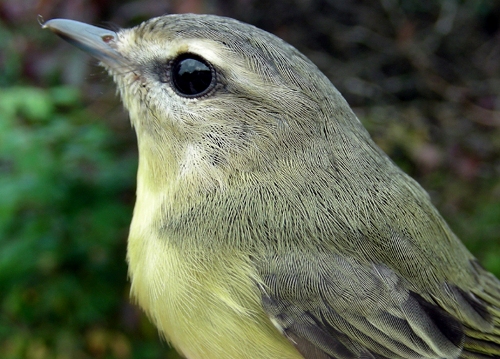|
McGILL BIRD OBSERVATORY |
|||||||||||||||||||||||||||||||||||||||||||||||||||||||||||||||||||||
Welcome
to the McGill Bird Observatory weekly report.
Click here for a complete listing of our archives.
Banders-in-charge: Simon Duval, Gay Gruner Notes: Last year at this time we were shocked with an unprecedented deluge of Yellow-rumped Warblers - 881 of them banded, as part of a record weekly banding total of 1279. Although we certainly didn't expect a repeat of that spectacular show this year, our total of 241 birds banded this week was admittedly a bit disappointing in comparison. Prior to 2010, our five-year average for week 8 was 333, with a range from 209 in 2007 to 480 in 2005. Our cumulative total for the season now lies around our 2005-2009 average, with our traditional peak weeks just ahead, so we expect that our numbers will increase soon.
Although relatively few birds were banded, it was a good week for observations, with the count of 87 only one short of the record total in 2005, and well above the six-year average of 81. Among them was our first-ever sighting of a Tundra Swan flying past, the 203rd species for the MBO checklist, and the first new addition since August 2010. Also observed for the first time in 2011 was Grey-cheeked Thrush, while Pine Siskin made its first appearance this fall, and we also saw our first "Yellow" Palm Warbler of the season. The total of species banded this fall has increased to 63, still quite a bit lower than usual for this point in the season. Three species this week were banded for the first time in 2011 (Cooper's Hawk, Grey-cheeked Thrush, and Yellow Palm Warbler), while another two were new for the fall (Northern Parula and Ruby-crowned Kinglet).
The top five species banded this week were remarkably similar to last week's list, with the exception of the mid-fall arrival of Ruby-crowned Kinglets, and Blackpoll Warbler dropping slightly this week to a tie for 7th place. This marks the fifth straight week that Magnolia Warbler has held top spot, and for the past four weeks, Tennessee Warbler has also been consistent as the runner-up! Both species are now past their typical peak of migration, by a couple of weeks in the case of Magnolia Warbler. The total count for Magnolia Warblers this fall now stands at 247, which is still a bit short of the record of 264 in 2008, but Tennessee Warblers have obliterated last year's record of 114, with 183 and counting this fall. By this time of year we would normally expect Yellow-rumped Warbler to be taking over, but whereas we banded 881 of them in this week last year, we only managed 10 this week, barely enough to tie for the final spot in our top ten list. Also of note was the strong showing by Chipping Sparrow, typically an uncommon migrant at MBO. In fact, the 11 banded this week is just one short of the single-week record, also set in week 8 (but back in 2005), and it matches or exceeds the entire fall total for four of the past five years. Dropping off the list since last week were Gray Catbird, American Redstart, Wilson's Warbler, and Indigo Bunting. However, the three American Redstarts banded this week increased the season total to 149, matching last year's record, and it seems likely that at least a few more will yet be banded this fall. Among species observed, there were also relatively few changes compared to last week, except for Ring-billed Gull jumping on all the way up in second place. White-throated Sparrow numbers are usually building at this time of year, so a mean daily count of only 15 was a surprise (between 2005 and 2010, the mean daily count during week 8 was 38). Canada Goose took top spot for the third time in the past four years, having been displaced only last year by Yellow-rumped Warbler, which didn't even make the top ten for the week this year. In addition to Ring-billed Gull, American Robin and European Starling were added to the list this week, displacing Tennessee Warbler, Magnolia Warbler, and American Goldfinch from last week. With September numbers having generally been subpar after a promising start to the season, we are eagerly looking forward to the next three weeks, which are traditionally the peak of fall migration at MBO, and hoping that the recent trend will be reversed.
|





